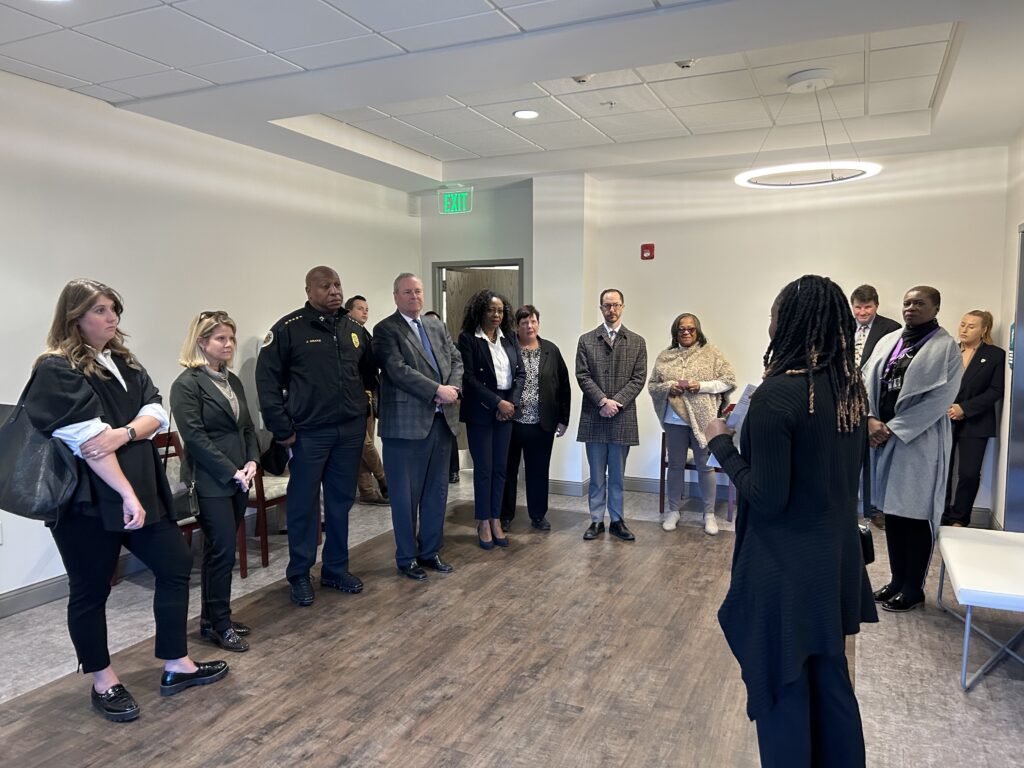
About 200 people gathered at Nashville’s Family Safety Center to observe its fifth anniversary working with victims of domestic and sexual violence, child and elder abuse, and human trafficking. Since opening in 2019, they’ve received over 55,000 in-person and remote visits from survivors.
The event kicked off with doughnuts, coffee, and a few short remarks from Mayor Freddie O’Connell. The crowd of attendees included survivors of domestic violence, advocates, elected officials and law enforcement, including Nashville Police Chief John Drake and District Attorney Glenn Funk.
The Family Safety Center helps victims with things like housing, counseling, and filing orders of protection, all in one central location. That wasn’t always the case, explained Director Diane Lance.
Ten years ago, Lance helped author a scathing 185-page report on domestic violence in Davidson County. The report highlighted the steep barriers victims faced when trying to get help, and the ways in which the current system was failing them.
Creating a place like the Family Safety Center was one of the report’s top recommendations.
“It was a wonderful opportunity for the city to take the brave move of looking at areas they could do better systemically to improve the experience for victims of domestic violence, improve their safety and improve offender accountability,” said Lance.
“This building, this Family Safety Center, was one of the large recommendations in that report. We needed a place under one roof where victims don’t have to go from one place to the other to get all the help that they need.”
The celebration included an immersive activity called “In Her Shoes,” in which participants followed a victim of domestic violence as they tried to navigate a complex and disconnected network of shelters, hospitals, interpreters and law enforcement to try to get help. It’s an educational tool designed by the Washington State Coalition Against Domestic Violence based on stories collected from survivors.
 Rose Gilbert WPLN News
Rose Gilbert WPLN News A group including the mayor, Police Chief John Drake and District Attorney Glenn Funk, followed the story of 24-year-old “Lena” as part of an immersive activity called “In Her Shoes.”
One group followed 24-year-old Lena, who moved to America from Ukraine to marry her penpal Gary, who is in his late thirties. Gary becomes abusive, but it is difficult for Lena to get help: she doesn’t have any family in the area, speaks limited English and worries that she could potentially be deported if she goes to the police.
At the beginning of the activity, the group is given two options: get medical help or go to the police. They decide to go to the hospital, where they have to set a timer to emulate waiting for an interpreter to show up and explain what the doctor is asking her. After that, the group decides that “Lena” will go to a women’s shelter, but have to flip a coin to see if they have space for her. When Lena does get a bed in the shelter, the group is given the option of attending a support group for women who have been hurt by their husbands. Then, once again, “Lena” has to wait for an interpreter, who then disparages her for coming to America to marry an older man. The interpreter’s comments depress Lena so much that she goes back home to Gary, who brings her a fruit basket and promises never to hurt her again.
It’s a frustrating and uncertain ending to the story, but it’s not the worst one: the activity includes a station labelled “Funeral Home,” representing those who were eventually killed by their abusive partners.
Lance said the activity shows how important it is to gather resources and services for survivors in one place to improve their chances of getting help and getting out of an abusive situation. Even more importantly, she added, it helps participants to think about the barriers victims of domestic violence face when trying to leave.
“It is so easy when we are not in a similar situation to be judgmental,” said Lance, “But when you really try to put yourself into someone else’s life and think what decisions they might need to make to be safe or to continue supporting their children, [it shows] what a complicated and hard path that that can be. And we hope that this Family Safety Center is making that path a lot less complicated and hard.”

